Chapter 5 Our Environment Multiple Choice Questions And Answers
Question 1. The table lists some components of an ecosystem.
Rain, Water, Butterfly, Air, Grass, Bacteria, Fungi, Sunlight. A student wants to classify these into abiotic components from biotic components separately. Which option correctly shows the classification done by the student?
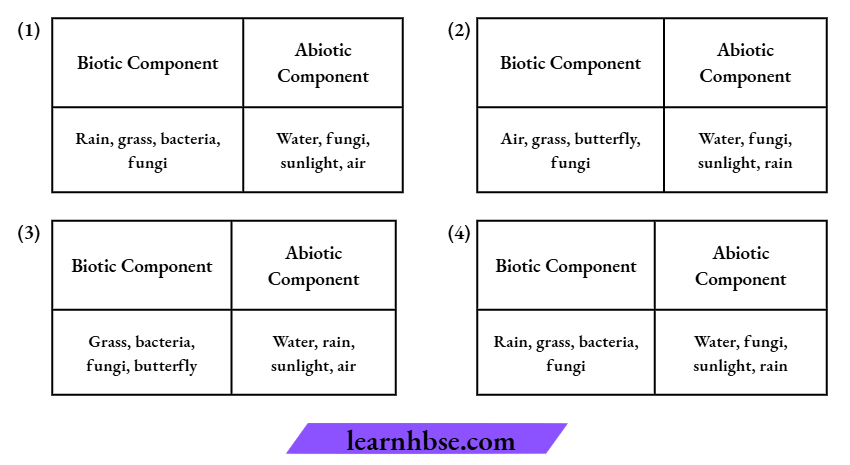
Answer: 
Question 2. Which statement shows interaction of an abiotic component with a biotic component in an ecosystem?
- A grasshopper feeding on a leaf,
- Rainwater running down into the lake.
- An earthworm making a burrow in the soil.
- A mouse fighting with another mouse for food.
Answer: 3. An earthworm making a burrow in the soil.
Question 3. The table shows some organisms including plants, animals and how they get energy.
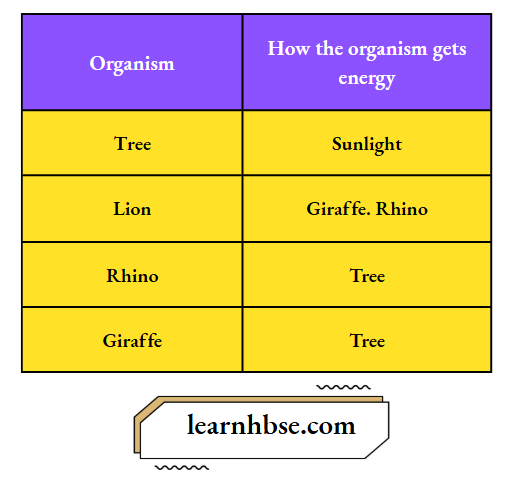
Which option shows the correct model made based on the table?
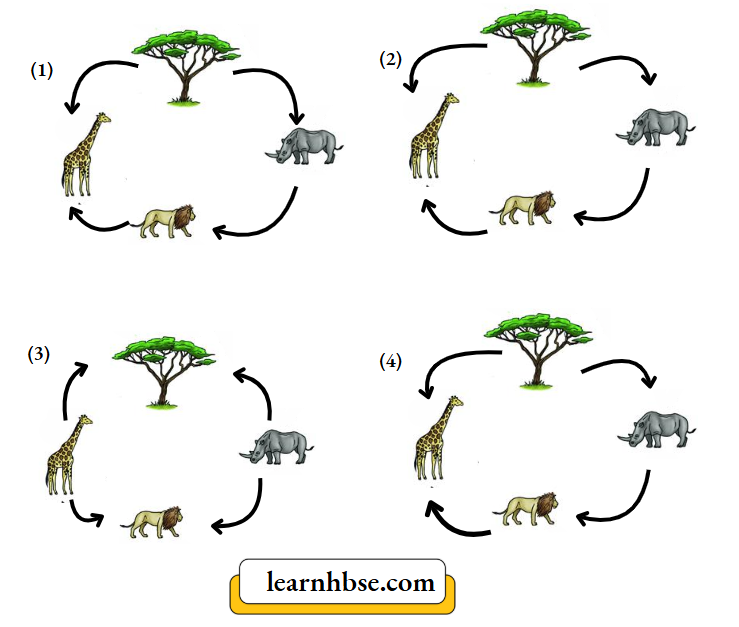
Answer: 1.
Question 4. The image shows a food web.
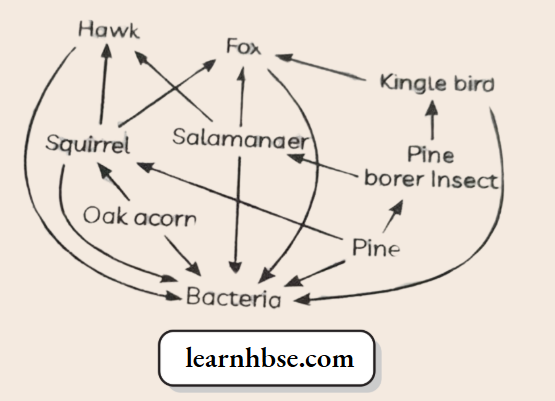
- Fox feeds on hawk obtain energy,
- Hawk feeds on oak acorn to obtain energy.
- Squirrel feeds on pine borer to obtain energy,
- Salamander feeds on pine borer to obtain energy.
Answer: 4. Salamander feeds on pine borer to obtain energy.
Question 5. The manufacturing of Chlorofluorocarbons free refrigerators is mandatory throughout the world. How this help prevent ozone depletion?
- This will help convert oxygen molecules into ozone.
- This will help convert the CFCs into ozone molecules.
- This will reduce the production of CFC from oxygen molecules.
- This will reduce the release of CFCs that reacts with ozone molecule
Answer: 4. This will reduce the release of CFCs that reacts with ozone molecule
Question 6. Ozone forms by combination of free oxygen atoms and oxygen molecules. How do free oxygen atoms form at higher levels of atmosphere?
- By splitting of molecular oxygen into free oxygen atoms in the presence of low energy uv radiations
- By splitting of a molecular oxygen into free oxygen atoms in presence of high energy uv radiations
- By the combination of two molecular oxygen in the presence of high energy uv radiations
- By the combination of two free oxygen atoms in the presence of lower energy UV radiations
Answer: 2. By splitting of a molecular oxygen into free oxygen atoms in presence of high energy uv radiations
Question 7. Some waste products are listed below:
Grass cutting; Polythene bags; Plastic bags; Used tea bags; Paper straw; Old clothes Which group of waste materials can be classified as non-biodegradable?
- Plant waste, used tea bags
- Polyethene bags, plastic toys
- Used tea bags, paper straw
- Old clothes, broken footwear
Answer: 2. Polyethene bags, plastic toys
Question 8. The table shows some waste materials that changed and remain unchanged when buried in the soil. Plastic box; Bubble wrap; Vegetable peels; Rubber tyre; Empty carton.
What materials correctly classified biodegradable and non-biodegradable materials?
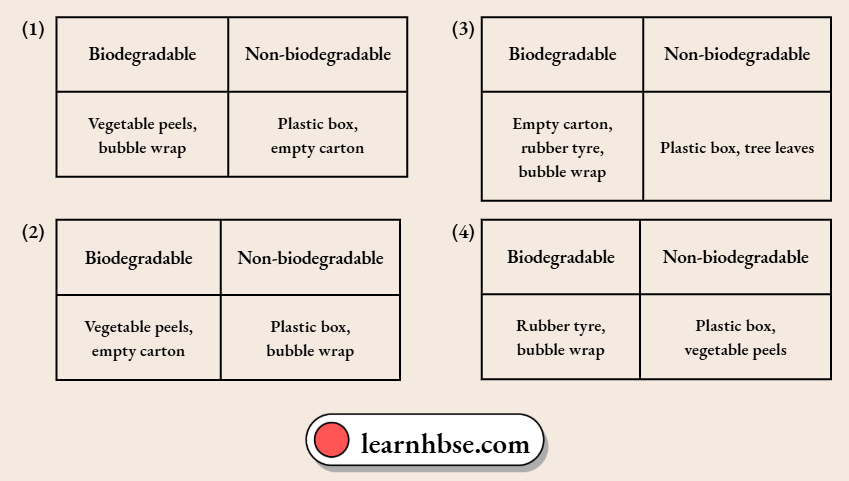
Answer: 
Question 9. Every food chain in the ecosystem begins with ___ which are the original source of food.
- Saprophytes
- Parasites
- Producers
- Herbivores
Answer: 4. Herbivores
Question 10. We should reduce the use of the plastic bags, bottles etc. because:
- They are not durable
- They are non-biodegradable
- They are made of toxic materials
- They react with the atmospheric gases
Answer: 2. They are non-biodegradable
Question 11. Which among the following statements is incorrect in view of the plants?
- They convert the solar energy into mechanical energy
- They prepare their food from organic compounds
- They are also called producers
- They are the initial source of energy in a food chain
Answer: 2. They prepare their food from organic compounds
Question 12. In a food chain the second trophic level is occupied by:
- Carnivores
- Autotrophs
- Herbivores
- Producers
Answer: 3. Herbivores
Question 13. The process of accumulation of harmful chemical substances like pesticides, in the body of living organisms at each trophic level of a food chain is known as:
- Biological magnification
- Biological accumulation
- Chemical magnification
- Chemical accumulation
Answer: 1. Biological magnification
Question 14. Which of the following may be a conclusion of the excessive exposure of humans to sun’s ultraviolet rays?
- Peptic ulcers
- Eye disease like cataract
- Damage to lungs
- Skin cancer
- (1) and (4);
- (2), (3) and (4);
- (2) and (4);
- Only (4)
Answer: 3. (2) and (4);
Question 15. Which among the following is a correct full form for DDT?
- Dichlorodiphenyltrichloroethane
- Dichlorodiphenyltetrachloroethane
- Dichlorodecaphenyltrichloroethane
- Dichlorodiethyltrichloroethane
Answer: 1. Dichlorodiphenyltrichloroethane
Question 16. Which of the following radiations is responsible for the conversion of atmospheric oxygen to ozone?
- Gamma radiations
- Cosmic radiations
- Infrared radiations
- Ultraviolet radiations
Answer: 4. Ultraviolet radiations
Chapter 5 Our Environment Very Short Answer Questions
Question 1. How much percentage of solar radiation is absorbed by the green plants during photosynthesis?
Answer: 1% of solar radiation is absorbed by the green plants during photosynthesis.
Question 2. Why plastic is not degraded by bacteria?
Answer: Plastic is not degraded by bacteria because they do not have enzymes to degrade plastic.
Question 3. List any one eco-friendly practice.
Answer: Carrying cloth bag while shopping is an eco-friendly practice.
Question 4. Name the process which is a direct outcome of excessive burning of fossil fuels.
Answer: Global warming is a direct outcome of excessive burning of fossil fuels.
Question 5. What will happen if deer is missing in this food chain?
Grass →Deer → Tiger
Answer: If deer is missing in the given food chain, the population of tiger will decrease and the population of grass will increase.
Question 6. Construct a food chain comprising of a snake, hawk, rat and plant.
Answer: Plant → Rat → Snake→ Hawk.
Question 7. Write one aquatic food chain.
Answer: Phytoplankton → Zooplankton → Small fishes → Large fishes
Question 8. Which of the following belong to the same trophic level: grasshopper, spider, grass, hawk and lizard?
Answer: Grasshopper and spider.
Question 9. Why some materials are biodegradable whereas others are non-biodegradable?
Answer: It is due to the property of decomposer organisms of being specific in their action that some waste materials are biodegradable whereas others are nonbiodegradable.
Question 10. In a food chain consisting of snake, insect, grass and frog, assign an appropriate trophic level to frog.
Answer: Grass -> insect -> frog -> snake
Question 11. Ozone is deadly poisonous; still it performs an essential function. How?
Answer: Ozone performs an essential function by forming an ozone layer which shields the surface of the earth from the entry of UV rays from the sun.
Question 12. How is depletion of ozone layer in the atmosphere responsible for causing skin cancer?
Answer: Ultraviolet rays can pass through ozone hole and causes skin cancer.
Question 13. We do not clean ponds or lakes, but an aquarium needs to be cleaned. Why?
Answer: An aquarium is an artificial and incomplete ecosystem compared to pond or lakes which are natural, self-sustaining and complete ecosystem where there is a perfect recycling of materials. Therefore, it needs to be cleaned.
Question 14. Which methodology is preferred for reducing the problem of waste disposal?
Answer: The 5R approach
Question 15. Give reason why a food chain cannot have more than four trophic levels.
Answer: Only 10% of the energy gets transferred from one trophic level to the next. So after 3 or 4 trophic levels, the energy available for passing on is too less to support another trophic level. Very little usable energy remains after 4 trophic levels. Hence the number of trophic levels in a food chain is limited.
Question 16. How is the increase in demand for energy affecting our environment adversely?
Answer: The increase in demand for energy affects our environment adversely. Due to this increase, pollutants like CO, CO2 and SO2 are released into the atmosphere which leads to greenhouse effect.
Question 17. Explain how ozone being a deadly poison can still perform an essential function for our environment.
Answer: The ozone layer is a thin part of the Earth’s atmosphere that absorbs almost all of the sun’s harmful ultraviolet light. It protects earth from the ultraviolet radiations which come from the sun.
Question 18. Which of the following belong to the same trophic level? Tree, Crow, Lion, Grass, Deer
Answer: Tree and Grass (both are producers)
Chapter 5 Short Answer Type Questions And Answers
Question 1. Why is there a need to ban the use of polythene bags?
Answer: Polythene bags need to be banned because they are non-biodegradable; microorganisms are unable to decompose them. So, they keep on accumulating in the environment and cause land pollution.
Question 2. Why a vegetarian food habit help us in getting more energy?
Answer: A person having a vegetarian food habit is close to the producer level and gets maximum amount of energy as compared to the organisms at a higher trophic level as only 10% of energy is passed on from one trophic level to another.
Question 3.
We do not clean ponds or lakes on a regular basis, but an aquarium needs to be cleaned regularly. Explain.
Answer:
A pond is an example of a natural ecosystem, whereas an aquarium is an example of an artificial ecosystem. Ponds do not need to be cleaned on a regular basis because they have natural flora and fauna present in them which helps in cleaning the pond ecosystem.
However, an aquarium does not contain soil and decomposing bacteria which help in degrading complex organic substances into simpler inorganic substances. Therefore, an aquarium needs to be cleaned regularly.
Question 4. “Industrialization is one of the main causes of deterioration of environment”. List any four reasons in favour of this statement.
Answer:
Industrialisation causes following effects on the environment- Noise and air pollution caused due to industrialization disturbs the environment; Waste released from industries leads to water pollution; SO2, NO2 etc. emitted by the industries, are toxic; Radioactive radiations emitted by nuclear power stations are toxic to living organisms.
Question 5. Pesticides are useful to farmers yet considered as pollutants. Given reasons.
Answer:
Pesticides kill insects and pests thereby protect the crops but these pesticides remain on the crops which enter the food chain and get accumulated in the organisms at the top most tropic level that causes diseases. When these are washed away by rain river water, it also causes pollution.
Question 6. Damage to the ozone layer is a cause for concern.” Justify this statement. Suggest any two steps to limit this damage.
Answer:
Ozone layer prevents the harmful ultraviolet radiation to enter the atmosphere and reach the earth’s surface. Depletion of ozone layer has become a cause for concern because it can cause serious effects on human body and other organisms of the environment like fatal diseases such as skin cancer, changes in genetic material DNA and eye damage.
Two steps to limit this damage are:
- Judicious use of aerosol spray propellants such as fluorocarbon and chlorofluorocarbons which cause depletion or hole in the ozone layer,
- Control over large scale nuclear explosions and limited use of supersonic planes.
Question 7. What will happen if we kill all the organisms in one trophic level?
Answer:
Killing all the organisms in one trophic level would decrease the availability of food at the next trophic level. It will also result in excess of organisms at the previous trophic level. This would cause an imbalance in the food chain.
Question 8. In the following food chain, plants provide 500 J of energy to rats. How much energy will be available to hawks from snakes?
Plants → Rats → Snakes → Hawks
Answer:
On applying the 10% law to the given food chain- Plants -> Rats → Snakes → Hawks
Energy available to snakes from rats = 10% of 500 = 10/100 x 500 = 50 J
So, energy available to hawks from snakes = 10% of 50 J
= 10/100 x 50 = 5J
Question 9. Which one of the following food chain is better and why?
Plant → Man
Plant → Goat → Man
Answer:
Food chain
- Is better than food chain
- In a shorter food chain maximum transfer of energy takes place according to ten percent law of nature.
Question 10. Observe the given food chain. Plant (1000 KJ) → Goat → Lion
If autotrophs occupying the first tropic level are called producers what are herbivores called?
How much energy does the lion get in the above food chain?
Answer:
- Primary consumers;
- When 10% law is applied, the goat gets 100 kJ and lion gets 10 kJ.
Question 11. Plastic cups were used to serve tea in trains in early days- these could be returned to the vendors, cleaned and reused. Later, Kulhads were used instead of plastic cups. Now, paper cups are used for serving tea. What are the reasons for the shift from Plastic to Kulhads and then finally to paper cups?
Answer:
Use of plastic cups raised the concern towards hygiene, and thus they were replaced by disposable plastic cups. Plastic cups are non-biodegradable and harm the environment.
They were thus replaced by Kulhads. Making Kulhad made of clay on a large scale resulted in the loss of top fertile soil.
Now, disposable paper cups are used because paper can be recycled, it is biodegradable and is ecofriendly material which does not cause environmental pollution.
Question 12.
- Give two examples of decomposers present in an ecosystem.
- How is the presence of decomposers crucial in the ecosystem?
Answer:
Bacteria and fungi are examples of decomposers present in an ecosystem,
Decomposers breakdown or decompose the dead remains of plants and animals and their waste organic products into simpler, inorganic substances. The latter are released into the environment for their reuse as raw materials by producers. Thus, decomposers provide space for new life to settle in the biosphere. Hence, their presence is crucial to the functioning of the ecosystem.
Question 13. Refer to the given food web.
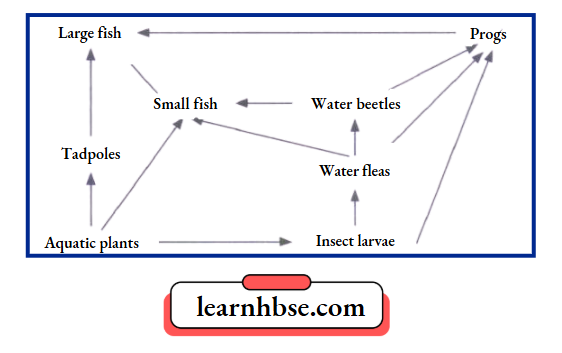
- What will be the effect on food web if population of water fleas gets eliminated?
- In the given food web, which organism operates at both primary and tertiary consumer level?
Answer:
- In the given food web, water fleas feed on insect larvae and are in turn fed by water beetles. So, if water fleas get eliminated, then population of insect larvae will increase and that of water beetles will decrease. As small fish are dependent on water beetles for food, a decrease in population of water fleas will cause a decrease in their population as well. Population of frogs remain unaffected as frog also depend on insect larvae for food.
- Small fish operates at both primary and tertiary consumer level in the given food web. Aquatic plant – Small fish – Large fish – Aquatic plant – Insect larvae – Water fleas – Small fish – Large fish
Question 14. A modern insecticide has been introduced with certain new properties like accumulation in the bodies of predators, broken down by soil bacteria, easily washed into lakes and rivers and taken up by plant roots. Among all these properties which one will help in reducing or keeping the level of environment pollution to lowest.
Answer:
The property of newly developed insecticide includes that it can easily get decomposed into simpler components by soil bacteria, i.e. biodegradable, which will help in the reduction of environmental pollution.
Question 15. In the following food chain, 5 J of energy is available to man. How much energy was available at producer level?
Plant-Sheep-Man
Answer:
Energy available to man in the above food chain is J5. According to 10% law, energy available to sheep is 50 J. Again according to 10% law, energy available to plants, i.e., at produce level is 500 J.
Question 16. Rearrange the following according to their trophic levels in a food chain.
Fish, zooplankton, seal, phytoplankton
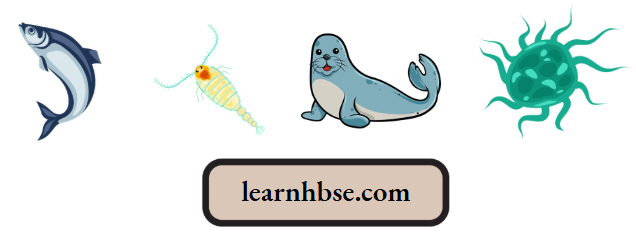
Answer:
Since a food chain always starts with producers followed by primary, secondary and tertiary consumer, thus, the food chain will be Phytoplankton, zooplankton, fish, seal.
Chapter 5 Long Questions And Answers
Question 1.
- Our food grains such as wheat and rice, vegetables and fruits, and even meat are found to contain varying amounts of pesticide residues. State the reason to explain how and why it happens?
- Make food chains in
- Forest
- Grassland. How does food chain differ from a food web?
Answer:
- Harmful pesticides like DDT enter the plant body on being absorbed from the soil. When these are eaten by animals they get accumulated in the animal’s body as they are neither metabolized nor excreted out of their body. The concentration of these harmful chemicals gets increased at successive levels and are thus found in food grains as well as meat,
- The food chains are:
- Forest: Plants → Deer Lion
- Grassland: Plants → Grasshopper → Frog → Snake → Eagle
Food chain is a series of organisms feeding on one another while the food web is a network of food chains consisting of a number of interlinked food chains.
Question 2. Draw a sequence of suitable methods of disposal of waste produced at your home to minimise environmental pollution.
Answer:
The household waste produced from various activities is called garbage and its proper disposal is done in such a way that it does not cause environmental pollution. Methods of waste disposal include:
Recycling: The processing of certain wastes to form new products is called recycling, For Example. paper, glass
etc., are recyclable,
Composting: It is the process of collecting biodegradable wastes like leftovers of food items, peels, etc. and burying them in a pit and using it as manure.
Incineration: It is burning of a substance at high temperature to reduce it to ashes.
Landfills: Dumping of non-biodegradable waste in low-lying areas is called landfill,
Sewage treatment: In sewage treatment plants, the sewage is
processed and decomposed into simpler inorganic chemicals.
Question 3. The activities of man had adverse effects on all forms of living organisms in the biosphere. Unlimited exploitation of nature by man disturbed the delicate ecological balanced between the living and non-living components of the biosphere. The unfavourable conditions created by man himself threatened the survival not only of himself but also of the entire living organisms on the mother earth. One of your classmates is an active member of ‘Eco dub’ of your school, which is creating enviromental awareness amongst the school students, spreading the same in the sociey and also working hard for preventing environmental degradation of the surroundings.
- Why is it necessary to conserve our environment?
- State the importance of green and blue dustbins in the safe disposal of the household waste.
- List two values exhibited by your classmate who is an active member of Eco-club of your school?
Answer:
- It is necessary to conserve our environment for the sustenance of the present life and also for the future generations. We exist because of support and supply from nature our sole existence is not possible.
- Green dustbin (for biodegradable waste) and blue dustbin (for non-biodegradable waste) should be used in household for the proper segregation of waste. If both type of waste are segregated, they can be treated accordingly,
- My classmate reflects eco-friendly nature, concern towards the
environment and knowledge of environmental issues.
Question 4.
- Why energy transfer is said to be unidirectional whereas biochemical transfer is said to be cyclic?
- Suggest any three activities in daily life which are eco-friendly.
Answer:
- Energy transfer is said to be unidirectional because when the energy is absorbed by autotrophs from the sun, it is never reabsorbed by it. Similarly when consumers eat up the producers directly or indirectly the energy transferred in this process can never be reversed in the food chain. In biogeochemical cycles chemical elements move from environment to organism and back to the environment.
- Activities in daily life which are eco-friendly: Separation of biodegradable and nonbiodegradable substances; Gardening; Use of gunny bags or paper bags in place of polythene or plastic bags; Use of compost and vermicompost in place of fertilisers; Harvesting rainwater.
Question 5.
- What is biological magnification? Will the levels of this magnification be different at different levels of the ecosystem? Where will the magnification be maximum?
- DDT that was sprayed in minute amount on food plants was detected in high concentration in man? How did it happen? Explain.
Answer:
- The accumulation or increasing concentration of a substance such as a toxic chemical in the body of living organisms at different trophic levels in a food chain is called biological magnification. Yes, the concentration of these harmful chemicals will be different at different levels of the ecosystem. It will be maximum at the last trophic level which is mostly occupied by the top carnivores (quaternary consumers),
- DDT that was sprayed in minute amount on food plants was detected in high concentration in man due to biological magnification. When pesticides like DDT are used to protect crops from diseases and pests. These non-biodegradable substances enter the soil. From soil these substances are absorbed by plants along with water and minerals. The food plants when consumed by organisms, they get accumulated at different trophic levels. As the human beings occupy the top position in any food chain, maximum concentration of such harmful chemicals get accumulated in the bodies of man.
